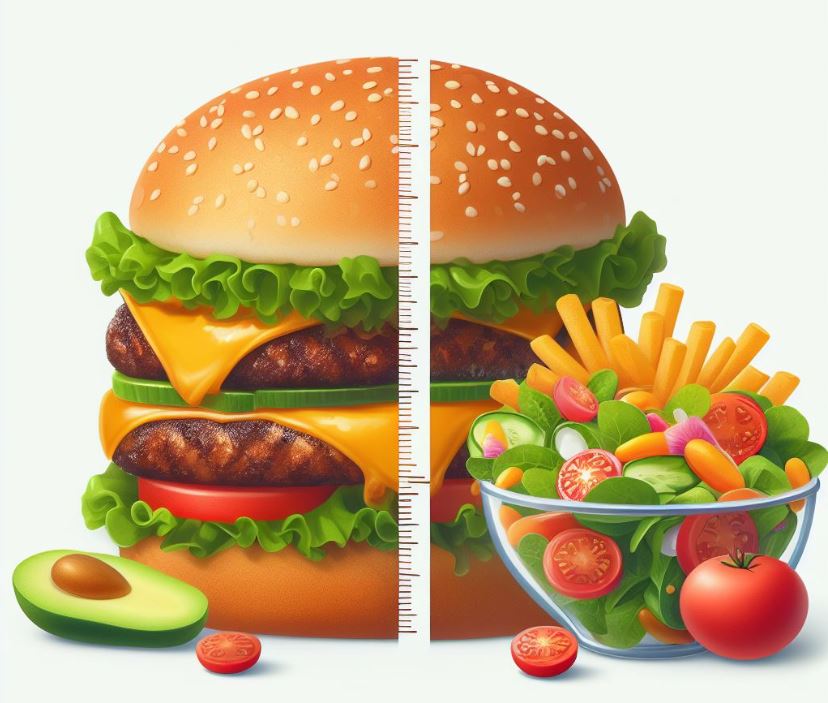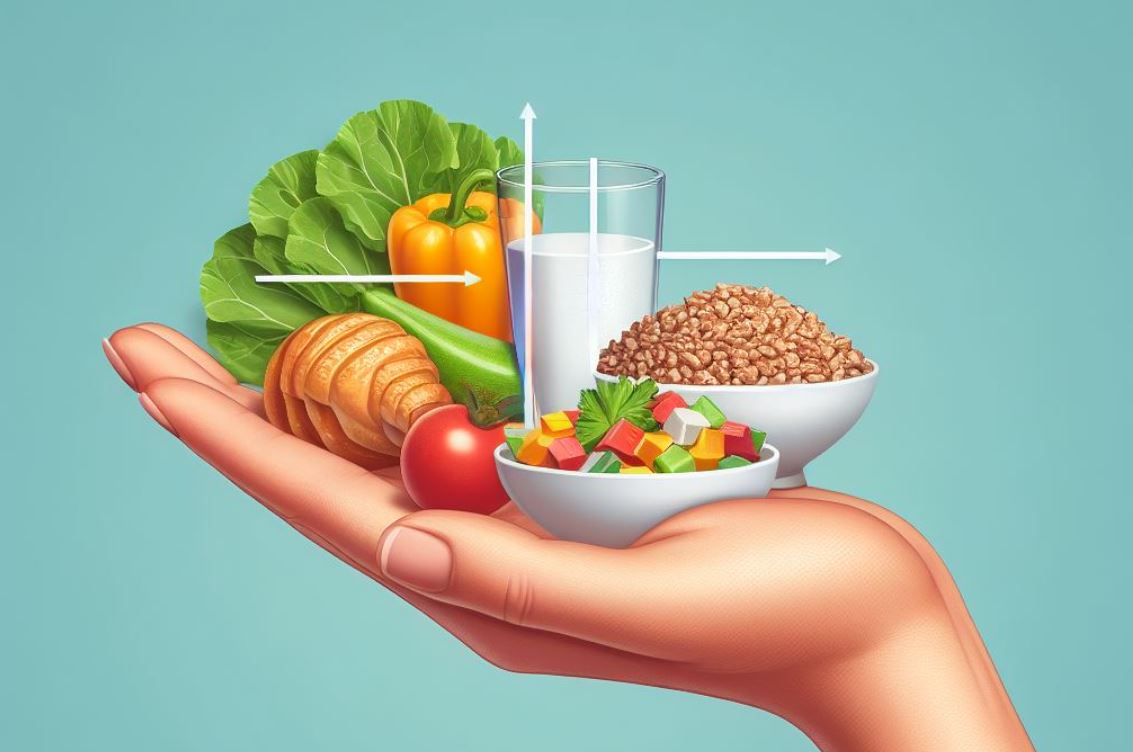Weight management is a topic that captivates the minds of many around the world. Whether it’s for health reasons or to meet personal goals, understanding how to lose weight in a healthy and sustainable way is essential. In this article, we will delve into the science of weight loss, separating fact from fiction. We’ll explore the concept of a “calorie bank,” where you either store or spend calories, and discuss the importance of making informed dietary choices.
The Calorie Bank: Earnings and Expenses
Imagine your body as a bank, but instead of money, it deals in calories. The calories you consume are like deposits into your account, while the calories you burn represent withdrawals. To lose weight, you must create a deficit by either increasing your calorie expenditure or reducing your calorie intake.
This calorie bank concept serves as the foundation for weight management. By grasping this simple idea, you can approach weight loss with a clearer perspective. It’s all about balance – spend more than you earn, and your body will start utilizing its stored calories, leading to weight loss.
The Sources of Calories
Understanding where calories come from is crucial. Calories are units of energy found in the food and drinks we consume. Everything our bodies do, from pumping blood to digesting food, requires energy, and calories are the fuel for these processes. While exercise is a common way to burn calories, it’s essential to recognize that even when at rest, our bodies continue to expend calories to maintain basic functions.
The calories we consume come from various sources, primarily food and non-water beverages. Each type of food provides energy, and different foods require different levels of energy to digest, absorb, and store. This is where the concept of the “Thermic Effect of Food” (TEF) comes into play. TEF reflects the energy expenditure associated with processing the foods we eat. Some foods, like proteins and high-fiber vegetables, have a high TEF, meaning they require more energy to digest. This knowledge can influence our dietary choices.
Basal Metabolic Rate (BMR)
Your Basal Metabolic Rate (BMR) is the number of calories your body burns at rest, just to maintain basic physiological functions like breathing, circulating blood, and regulating body temperature. Everyone’s BMR is unique and depends on various factors, including age, height, weight, muscle mass, and overall health.
You can calculate your BMR using online calculators, which take into account your age, height, weight, and gender. For example, a 28-year-old with a height of 186 cm and a weight of 80 kg may have a BMR of 1828 calories per day. This means they burn this many calories daily without any physical activity.
Understanding your BMR is crucial because it establishes the baseline for your daily caloric needs. To maintain your current weight, you’d aim to consume approximately this number of calories daily. To lose weight, you’d need to create a calorie deficit by either eating less or burning more through physical activity.
Thermic Effect of Food (TEF)
TEF is a fascinating concept related to calorie expenditure during the digestion and processing of food. Not all calories are equal when it comes to energy expenditure. Some foods require more energy to digest and absorb, while others are processed more efficiently.
For instance, fats, oils, flour, and butter have a low TEF, meaning they are easily digested, and little energy is expended during the process. On the other hand, foods like whole grains, protein-rich foods, dairy, high-fiber vegetables, and fruits have a high TEF. The body has to burn more calories to digest these foods, making it more challenging to gain weight by consuming them.
It’s important to note that while the concept of “negative calorie” foods, where the body burns more calories digesting the food than it provides, is a myth, understanding TEF can help you make informed food choices. The highest TEF typically achievable is around 30%, often seen with protein-rich foods. This means that if you eat 100 calories of protein, your body expends 30 calories to digest it, resulting in a net gain of 70 calories.
In practical terms, this knowledge highlights the importance of a balanced diet that includes a variety of food groups and sources of nutrients. Now, let’s delve deeper into effective weight loss strategies and the significance of a balanced diet.
Weight Loss Strategies: The Balanced Approach
When it comes to weight loss, the path to success involves a balanced approach that combines various elements to ensure both effectiveness and sustainability. Here’s a comprehensive guide to adopting a balanced strategy for healthy weight loss:
Balanced Diet Essentials
A balanced diet is at the core of any successful weight loss plan. To achieve healthy weight loss, you need to maintain a balanced intake of essential nutrients. The six key nutrients that your body requires are proteins, carbohydrates, fats, vitamins, minerals, and water.
Proteins are crucial for muscle building and repair, which is vital for maintaining overall health during weight loss. Include lean sources of protein in your diet, such as lean meats, poultry, fish, legumes, and low-fat dairy products.
Carbohydrates, often unfairly demonized, are essential for providing energy to your body. Opt for complex carbohydrates, such as whole grains, legumes, and starchy vegetables, which release energy slowly and keep you feeling full for longer.
Fats, both monounsaturated and polyunsaturated, are necessary for several bodily functions, including the absorption of fat-soluble vitamins and brain health. Good sources of healthy fats include olive oil, nuts, seeds, and fatty fish like salmon.
Incorporate a variety of fruits and vegetables into your diet to ensure you receive a wide range of vitamins and minerals. These essential micronutrients support various bodily processes and help maintain overall health.
Hydration is critical during weight loss. Water is essential for digestion, circulation, and temperature regulation. Drinking an adequate amount of water can also help control your appetite.
Healthy Carbohydrates and Weight Loss
One aspect of a balanced diet that often garners attention is the role of carbohydrates in weight loss. It’s a common belief that cutting carbs is the key to shedding pounds, but the reality is more nuanced.
Carbohydrates are your body’s primary source of energy. When you consume carbohydrates, your body converts them into glucose, which fuels your cells. Excess glucose is stored as glycogen in the liver and muscles. If your glycogen stores are full and you continue to eat more carbohydrates, the excess is stored as fat.
However, this doesn’t mean you should completely eliminate carbohydrates from your diet. Carbs are essential for brain function, and some foods, like fruits, vegetables, and whole grains, offer important nutrients.
Research supports the idea that it’s the overall calorie balance that matters most for weight loss. Studies have shown that low-carb and low-fat diets can be equally effective for weight loss if they create a calorie deficit. The key is to choose healthy carbohydrates like whole grains and minimize refined carbohydrates and added sugars.
The Healthy Approach to Fats
Fats have long been vilified as the culprits behind weight gain, but it’s crucial to differentiate between good and bad fats.
Unsaturated fats, such as monounsaturated and polyunsaturated fats, are considered heart-healthy and provide various benefits. They can help reduce the risk of heart disease and improve cholesterol levels. Good sources of these fats include avocados, olive oil, nuts, seeds, and fatty fish.
On the other hand, saturated fats, often found in animal products and some tropical oils, should be consumed in moderation. High intake of saturated fats can lead to elevated levels of LDL (bad) cholesterol, increasing the risk of heart disease.
Trans fats, found in some processed and fried foods, are the most harmful fats and should be avoided entirely. They raise LDL cholesterol and lower HDL (good) cholesterol, significantly increasing heart disease risk.
When aiming for healthy weight loss, focus on incorporating unsaturated fats into your diet and limiting saturated and trans fats.
Acceptable Macronutrient Distribution Ranges (AMDR)
The Acceptable Macronutrient Distribution Ranges (AMDR) offer guidelines for the ideal balance of macronutrients in your diet. These ranges help ensure that you receive the right proportions of carbohydrates, fats, and proteins.
According to the AMDR, approximately 45-65% of your daily calories should come from carbohydrates. This provides the necessary energy to fuel your daily activities.
Around 20-35% of your calories should come from fats, with an emphasis on healthy unsaturated fats. This allows you to meet your nutrient needs while managing calorie intake.
Proteins should contribute 10-35% of your daily calories, supporting muscle growth and repair. The specific distribution of macronutrients within these ranges can vary based on individual factors like age, physical activity, and health goals.
Crafting a Personalized Diet Plan
Creating a personalized diet plan is essential for effective and sustainable weight loss. Your ideal macronutrient distribution within the AMDR, specific calorie needs, and portion sizes depend on various factors.
Age, gender, activity level, and health status all play a role in determining your dietary requirements. Consulting a professional dietitian can help you tailor a diet plan that aligns with your unique needs and goals.
When designing your diet plan, remember that the key is to find a balance that works for you. It should prioritize nutrient-dense, whole foods while minimizing processed and high-sugar items. In the next section, we’ll delve into specific foods that can aid your weight loss journey.
High Satiety Foods for Portion Control
Ever felt like you’ve eaten a substantial meal but still found yourself hungry? The Satiety Index is a concept that sheds light on this phenomenon. It helps us understand why certain foods make us feel full, while others don’t.
In a study conducted in 1995, researchers assessed the satiety index of various foods based on 240-calorie servings. Boiled potatoes scored the highest, with a satiety index of 323, while croissants scored the lowest at 47.
Understanding which foods provide a greater feeling of fullness per calorie can be a valuable tool for managing portion control and reducing overall calorie intake. Here are some high-satiety foods to consider including in your diet:
Boiled Potatoes: As previously mentioned, boiled potatoes are highly satiating. They’re an excellent source of complex carbohydrates, fiber, and various nutrients.
Oatmeal: Oatmeal is rich in soluble fiber, which absorbs water and swells in your stomach, helping you feel full. It’s a wholesome and nutritious breakfast option.
Legumes: Beans, lentils, and chickpeas are packed with fiber and protein, making them incredibly filling and nutritious. They’re versatile and can be used in various dishes.
Lean Protein: Lean sources of protein, such as chicken, turkey, fish, and tofu, are known for their satiating effects. They promote muscle maintenance during weight loss.
High-Fiber Fruits and Vegetables: Foods like broccoli, spinach, apples, and berries are rich in fiber, which adds bulk to your meals and keeps you satisfied.
Nuts: Despite their calorie density, nuts are filling due to their healthy fats and protein content. A small portion can quell your hunger.
Greek Yogurt: Greek yogurt is high in protein and can be a satisfying snack or breakfast when paired with fruits and honey.
Eggs: Eggs are an excellent source of protein and healthy fats. They are known to increase feelings of fullness and reduce subsequent calorie intake.
By incorporating these high-satiety foods into your diet, you can manage portion control more effectively and reduce the overall calories consumed, which is essential for weight loss.
| Food Category | Examples | Satiety Score |
|---|---|---|
| Complex Carbohydrates | Boiled Potatoes, Oatmeal | High |
| Legumes | Beans, Lentils, Chickpeas | High |
| Lean Protein | Chicken, Turkey, Tofu | High |
| High-Fiber Fruits and Vegetables | Broccoli, Spinach, Apples, Berries | High |
| Nuts | Almonds, Walnuts, Pistachios | Moderate |
| Dairy | Greek Yogurt, Low-Fat Milk | Moderate |
| Eggs | Whole Eggs | Moderate |
| Processed Foods | Chips, Cookies | Low |
Portion Control and Mindful Eating
Effective portion control is a cornerstone of any successful weight loss strategy. It helps you manage calorie intake while still enjoying the foods you love. Mindful eating is a valuable technique for achieving portion control and maintaining a healthy relationship with food.
Here are some tips for practicing mindful eating and portion control:
Use Smaller Plates: Research shows that using smaller plates can lead to smaller portion sizes. This psychological trick can help you eat less without feeling deprived.
Slow Down: Eating too quickly can lead to overconsumption. Chew your food slowly, savor each bite, and give your body time to signal fullness.
Listen to Your Body: Pay attention to your body’s hunger and fullness cues. Eat when you’re hungry, and stop when you’re satisfied, not overly full.
Avoid Distractions: Eating in front of the TV or computer can lead to mindless overeating. Focus on your meal and savor the flavors.
Pre-Portion Snacks: When enjoying snacks, portion them into small bowls or containers to prevent mindless munching.
Practice the 80-20 Rule: Strive to stop eating when you’re about 80% full. This can help you avoid overindulging.
Plan Meals and Snacks: Knowing what you’ll eat in advance can help you make healthier choices and prevent impulsive overeating.
The Importance of Regular Exercise
Healthy weight loss isn’t achieved through diet alone; regular exercise is a crucial component. Exercise not only burns calories but also offers numerous health benefits. Here are some key points to consider:
Aerobic Exercise: Activities like brisk walking, running, swimming, and cycling are excellent for burning calories and improving cardiovascular health.
Strength Training: Building muscle through strength training can boost your metabolism and help you burn more calories, even at rest.
Flexibility and Balance: Incorporating activities like yoga or Pilates can enhance flexibility and balance, which are essential for overall fitness.
Consistency: The key to successful weight loss through exercise is consistency. Aim for at least 150 minutes of moderate aerobic activity or 75 minutes of vigorous activity each week, combined with strength training exercises at least two days a week.
Consult a Professional: If you’re new to exercise or have specific health concerns, it’s advisable to consult a fitness professional or healthcare provider to create a safe and effective exercise plan.
Sleep and Stress Management
Sleep and stress play significant roles in weight management. Poor sleep patterns and chronic stress can lead to weight gain and hinder weight loss efforts.
Quality Sleep: Aim for 7-9 hours of quality sleep per night. Poor sleep can disrupt hormones that regulate hunger and appetite.
Stress Management: Chronic stress can lead to emotional eating and poor food choices. Practice stress-reduction techniques like meditation, deep breathing, or yoga.
Hydration: Stay hydrated to support overall health and well-being. Sometimes, your body can confuse thirst with hunger.
Tracking Progress and Seeking Support
Tracking your progress is essential for staying motivated and making necessary adjustments. Consider these methods:
Journaling: Keep a food diary to monitor your eating habits and emotions related to food.
Measuring: Use a food scale or measuring cups to understand portion sizes better.
Apps and Tools: There are many apps and online tools available to help track your food intake, exercise, and weight loss progress.
Support System: Don’t hesitate to seek support from friends, family, or a weight loss group. They can provide encouragement and accountability.
In conclusion, a balanced approach to weight loss encompasses a nutritious diet, portion control, regular exercise, sleep, stress management, and support. It’s essential to focus on overall health and well-being and remember that sustainable weight loss takes time and patience. By implementing these strategies and staying committed to your goals, you can achieve lasting success on your weight loss journey.





